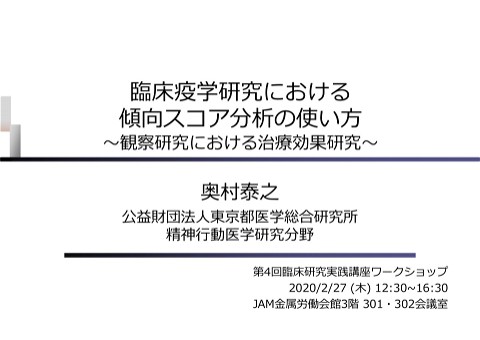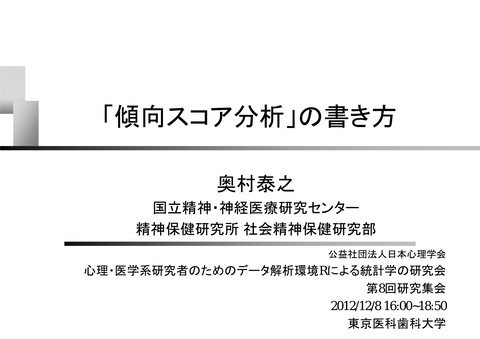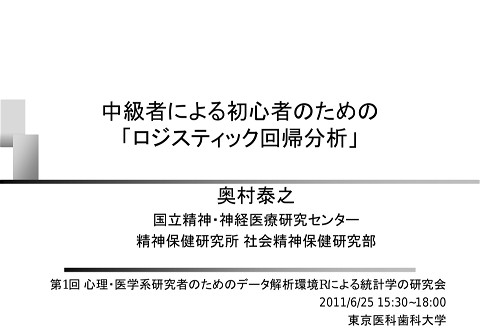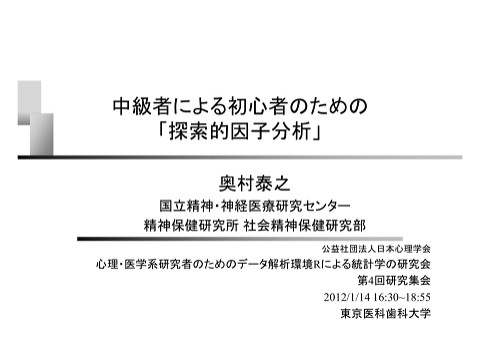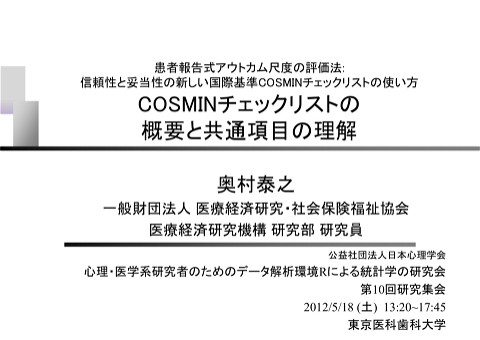「臨床的有意性」の書き方
7K Views
May 24, 22
スライド概要
関連スライド
各ページのテキスト
「臨床的有意性」の書き方 奥村泰之 一般財団法人 医療経済研究・社会保険福祉協会 医療経済研究機構 研究員 臨床疫学研究における報告の質向上のための統計学の研究会 第16回研究集会 2014/8/2 (土) 14:30~17:40 東京医科歯科大学湯島キャンパス1号館西7階 口腔保健学科 第3講義室
構成 臨床的有意性の特徴 (10 min) 測定誤差の求め方 (11 min) 分布に基づく方法 (5 min) アンカーに基づく方法 (13 min) 累積分布関数 (3 min) 推薦資料 (1 min) 2
特徴 測定誤差 分布 アンカー 累積分布 推薦資料 英語表記 Minimal Clinically Important Difference (MCID) Subjectively Significant Difference (SSD) Minimal Important Difference (MID) Clinical Significance (CS) Clinically Important Differences (CID) Clinically Significant Change Minimally Important Change (MIC) Minimally Detectable Difference (MDD) Standard Error of Measurement (SEM) Minimum Detectable Change (MDC) Smallest Real Difference (SRD) Smallest Statistically Detectable Difference (SDD) King MT: Expert Rev Pharmacoecon Outcomes Res. 2011 Apr;11(2):171-84. 3
特徴 測定誤差 分布 アンカー 累積分布 推薦資料 臨床的有意性の定義 (群間の差) FDAによるPROの指針 (草稿) 臨床試験において,ある治療が有効である と解釈できる,患者報告式アウトカム尺度 により観察された,治療群間の差や変化量 » Minimum important difference (MID) — The amount of difference or change observed in a PRO <Patient-Reported Outcome> measure between treatment groups in a clinical trial that will be interpreted as a treatment benefit. U.S. Department of Health and Human Services: Guidance for Industry: Patient-Reported Outcome Measures: Use in Medical Product Development to Support Labeling Claims. 2006 (http://www.fda.gov/ohrms/dockets/98fr/06d-0044-gdl0001.pdf) 4
特徴 測定誤差 分布 アンカー 累積分布 推薦資料 臨床的有意性の定義 (個人の変化) FDAによるPROの指針 (最終版) 標的集団において,事前に定められた期間 に,重要な治療の有効性が得られたと判断 できる,ある患者個人のある尺度の得点の 変化 » Responder definition — A score change in a measure, experienced by an individual patient over a predetermined time period that has been demonstrated in the target population to have a significant treatment benefit. U.S. Department of Health and Human Services: Guidance for Industry: Patient-Reported Outcome Measures: Use in Medical Product Development to Support Labeling Claims. 2009 (http://www.ispor.org/workpaper/FDA%20PRO%20Guidance.pdf) 5
特徴 測定誤差 分布 アンカー 累積分布 推薦資料 混乱した用語の使い分け 群間の差 個人の変化 事例 MID Responder [1-2] MID MIC [3] MCID MID [4] MCID --- [5] MCID [6] 注) MID = Minimal Important Difference; MIC = Minimally Important Change; MCID = Minimal Clinically Important Difference [1] U.S. Department of Health and Human Services: Guidance for Industry: Patient-Reported Outcome Measures: Use in Medical Product Development to Support Labeling Claims. 2006 (http://www.fda.gov/ohrms/dockets/98fr/06d0044-gdl0001.pdf) [2] U.S. Department of Health and Human Services: Guidance for Industry: Patient-Reported Outcome Measures: Use in Medical Product Development to Support Labeling Claims. 2009 (http://www.ispor.org/workpaper/FDA%20PRO%20Guidance.pdf) [3] de Vet HC et al: J Rheumatol. 2006 Feb;33(2):434-5 [4] Kirby S et al: J Biopharm Stat. 2010 Sep;20(5):1043-54. [5] Chan LS: Am J Public Health. 2013 Nov;103(11):e24-5. [6] Beaton DE et al: J Rheumatol. 2001 Feb;28(2):400-5. 6
特徴 測定誤差 分布 アンカー 累積分布 推薦資料 群間の差の決定の難しさ 群間の差の重要性は,「疾患」「利用できる 治療法」「治療のリスクベネフィット比」な ど,広いコンテクストを基にしなければ,決 定できない! » ...(前略) the determination of the importance of group differences, which can only be established in the broader context of the disease being treated, the currently available treatments, and the overall riskbenefit ratio of the treatment. Dworkin RH et al: J Pain. 2008 Feb;9(2):105-21. 7
特徴 測定誤差 分布 アンカー 累積分布 推薦資料 事例: 群間の差 目的 臨床医の観点から,喘息患者への治療群と プラセボ群の最小限の意味のある差を同定 研究法 デルファイ法 調査対象 臨床の時間は50%以上 3症例/週以上の喘息患者を治療 Harding G et al: Curr Med Res Opin. 2009 Jun;25(6):1563-71. 8
特徴 測定誤差 分布 アンカー 累積分布 推薦資料 事例: 群間の差 評価項目 下の尺度で示すよう に, プラセボ群の25%の患者は, す ぐ に薬が効き始めたと 感じたと 報告しました。 あなたの 臨床にと っ て意味のある効果になるためには, 治療群の 何パーセント程度の患者が反応したと 報告すれば良いか 答えて下さ い。 0% 反 応 な し 全 患 者 が 10 20 30 40 50 プラ セボ群 Harding G et al: Curr Med Res Opin. 2009 Jun;25(6):1563-71. 60 70 80 90 100% 反 全 応 患 者 が 9
特徴
測定誤差
分布
事例: 群間の差
アンカー
累積分布
推薦資料
プラセボ群の2~3倍の反応率で
治療群は意味がある!
治療群の反応率
Round 1, %
(プラセボ群: 25%)
Round 2, %
< 50
8
0
50-55
42
42
56-60
8
8
61-65
0
17
66-70
0
8
71-75
25
25
76-80
17
0
> 80
0
0
Harding G et al: Curr Med Res Opin. 2009 Jun;25(6):1563-71.
10
特徴 測定誤差 分布 アンカー 累積分布 推薦資料 事例: 個人の変化 目的 肩の問題を主訴とした外来患者における, アウトカム尺度の臨床的有意性を検討 研究法 コホート研究 評価項目 Simlpe Shoulder Test (SST) など 測定時点 基準時,6か月時 van Kampen DA et al : J Orthop Surg Res. 2013 Nov 14;8:40. 11
特徴 測定誤差 分布 アンカー 累積分布 推薦資料 事例: 個人の変化 アンカー 基準時と比べた変化の全体評定 • 1. 完全に改善 • 2. かなり改善 • 3. 少し改善 • 4. 不変 • 5. 少し悪化 • 6. かなり悪化 • 7. 以前より悪化 最小限の変化群 van Kampen DA et al : J Orthop Surg Res. 2013 Nov 14;8:40. 12
特徴 測定誤差 分布 アンカー 累積分布 推薦資料 事例: 個人の変化 SSTの最小限の変化は2.2 変化の全体評定 n 変化量の平均値 1. 完全に改善 14 2.9 2. かなり改善 37 2.9 3. 少し改善 23 2.2 4. 不変 43 -0.1 5. 少し悪化 5 -0.6 6. かなり悪化 6 -4.0 7. 以前より悪化 0 ― van Kampen DA et al : J Orthop Surg Res. 2013 Nov 14;8:40. 13
特徴 測定誤差 分布 アンカー 累積分布 推薦資料 臨床的有意性の定め方 (個人の変化) 分布に基づく方法 (distribution-based method) アンカーに基づく方法 (anchor-based method) 累積分布関数 (cumulative distribution functions) [1] McLeod LD et al: Expert Rev Pharmacoecon Outcomes Res. 2011 Apr;11(2):163-9. [2] Wyrwich KW et al: Qual Life Res. 2013 Apr;22(3):475-83. 14
特徴 測定誤差 分布 アンカー 累積分布 推薦資料 信頼性と妥当性の新しい国際基準(COSMIN) による臨床的有意性の位置づけ 信頼性 妥当性 内容的妥当性 内的一貫性 分布に基づく方法 信頼性 表面的 妥当性 測定誤差 基準関連 妥当性 反応性 反応性 解釈 可能性 Mokkink LB et al: J Clin Epidemiol. 2010 Jul;63(7):737-45. 構造的 妥当性 構成概念妥当性 異文化間 妥当性 仮説検定 アンカーに基づく方法 15
特徴 測定誤差 分布 アンカー 累積分布 推薦資料 研究デザインの基本はコホート研究 全患者 基準時 介入後 安定期 (t1) (t2) (t2+x日) 評価項目 ○ ○ × アンカー △ ○ × 測定 一部の患者 基準時 介入後 安定期 (t1) (t2) (t2+x日) 評価項目 ○ ○ ○ アンカー △ ○ ○ 測定 アンカーに基づく方法 分布に基づく方法 16
構成 臨床的有意性の特徴 (10 min) 測定誤差の求め方 (11 min) 分布に基づく方法 (5 min) アンカーに基づく方法 (13 min) 累積分布関数 (3 min) 推薦資料 (1 min) 17
特徴 測定誤差 分布 アンカー 累積分布 推薦資料 測定誤差と信頼性の定義 測定値 = 真値 + 測定誤差 x t e 信頼性 = 真値の分散/測定値の分散 2 t 2 x 18
特徴 測定誤差 分布 アンカー 累積分布 推薦資料 測定誤差の記載事項 (≒分布に基づく方法) 報告すべき点 1. 項目の欠測割合 (G) 7. 状態の安定性 2. 欠測値処理法 (G) 8. 実施間隔の適切性 3. 標本サイズの適切性 (G) 9. 実施の類似性 4. 二時点以上の測定 10. 重大な研究法の欠陥 (G) 5. 実施の独立性 11. 統計手法 6. 実施間隔 注) G = 共通項目; 赤字は記載事例を後述 Mokkink LN et al: COSMIN checklist manual. 2010 (http://www.cosmin.nl/images/upload/File/COSMIN%20checklist%20manual%20v6.pdf) 19
特徴 測定誤差 分布 アンカー 累積分布 推薦資料 測定誤差の記載事例 方法 (二時点以上の測定/実施間隔) » Using a web-based system at home, the patients completed an online questionnaire containing the four different body part-specific PROMs [Patient-Reported Outcome Measures] at three different time-points: T1(baseline), T2 (2 weeks after baseline), and T3 (6-month follow-up). 方法 (実施の類似性) » The given questionnaires were identical at all three time-points, except for two anchor questions added at T3 (see ‘ Outcome measures ’ for details). 方法 (状態の安定性) » Data from T1 and T2 were used to determine the measurement error. We assumed that there would be no real change in a patient's functioning within a 2-week interval (range, 1 to 4 weeks). van Kampen DA et al : J Orthop Surg Res. 2013 Nov 14;8:40. 20
特徴 測定誤差 分布 アンカー 累積分布 推薦資料 測定誤差の前段階,級内相関係数 ①説明用データ ID 時点1 時点2 1 88 90 2 57 54 3 82 68 4 59 53 5 75 80 6 70 45 縦もちに変換 ID 時点 評定 1 1 88 1 2 90 2 1 57 2 2 54 3 1 82 3 2 68 4 1 59 4 2 53 5 1 75 5 2 80 6 1 70 6 2 45 de Vet et al: Measurement in medicine. Cambridge University Press. 2011 21
特徴 測定誤差 分布 アンカー 累積分布 推薦資料 測定誤差の前段階,級内相関係数 ②2因子変量モデルで分散成分を推定 被験者の分散成分 ( δ ) 2 時点の分散成分 ( δt ) 誤差の分散成分 ( δe2 ) 2 p 2乗が分散成分 de Vet et al: Measurement in medicine. Cambridge University Press. 2011 22
特徴 測定誤差 分布 アンカー 累積分布 推薦資料 測定誤差の前段階,級内相関係数 ③級内相関係数 (Intraclass Correlation Coefficient: ICC) 一致性の級内相関係数 (ICCagreement) • 時点間の系統誤差を考慮 ICCagreement δ 2 p 2 t δ (δ δ ) 2 p 2 e 一貫性の級内相関係数 (ICCconsistency) 2 δp ICCconsistency 2 2 δ p (δe ) de Vet et al: Measurement in medicine. Cambridge University Press. 2011 23
特徴 測定誤差 分布 アンカー 累積分布 推薦資料 3つの測定誤差の算出法 ①分散成分による測定誤差の算出法 一致性の測定誤差 (SEMagreement) • 時点間の系統誤差を考慮 SEM agreement δt2 δe2 一貫性の測定誤差 (SEMconsistency) SEM consistency δ 2 e de Vet HC et al: J Clin Epidemiol. 2006 Oct;59(10):1033-9. 24
特徴 測定誤差 分布 アンカー 累積分布 推薦資料 3つの測定誤差の算出法 ②標準偏差による測定誤差の算出法 一貫性の測定誤差 (SEMconsistency) SDdifference SEM consistency 2 • SDdifference = 時点間の平均値差の標準偏差 de Vet HC et al: J Clin Epidemiol. 2006 Oct;59(10):1033-9. 25
特徴 測定誤差 分布 アンカー 累積分布 推薦資料 3つの測定誤差の算出法 ③級内相関係数による測定誤差の算出法 一貫性の測定誤差 (SEMconsistency) SEM consistency SD pool 1 ICCconsistency • SDpool = 合併した2時点の標準偏差 × 先行研究のICCの使用 × クロンバックのα係数の使用 de Vet HC et al: J Clin Epidemiol. 2006 Oct;59(10):1033-9. 26
特徴 測定誤差 分布 アンカー 累積分布 推薦資料 測定誤差の記載事例 方法 (統計手法) » The reliability of the NDI-DV [Neck Disability Index-Dutch Version] was assessed by rating test-retest reliability and measurement error [11]. The test–retest interval was set at 10 days. As parameter of reliability of the NDI-DV, the intra-class correlation coefficient (ICCagreement) was computed using a two-way random effects model (ICCagreement = σ2p/[σ2p +σ2m +σ2r]), where the error variance consists of a component representing the systematic difference between the two measurements (σ2m) and a component for the residual (random) error (σ2r) [12]. σ2p represents the systematic differences between the ‘‘true’’ scores of patients. Ailliet L et al: Eur Spine J. 2014 May 17 27
特徴 測定誤差 分布 アンカー 累積分布 推薦資料 測定誤差の記載事例 方法 (統計手法) » We quantified the measurement error by the Bland and Altman method and by calculating the standard error of measurement (SEMagreement) from the ICC formula, by taking the square root of the error variance (√[σ2m +σ2r]). 結果 (級内相関係数/測定誤差) » At the measurement time point of 6 months + 10 days, 155 patients (60.5 %) provided the information used to assess the reliability. An intraclass correlation coefficient (ICCagreement) of 0.88 was found. (中略) » The SEMagreement was 1.95. Ailliet L et al: Eur Spine J. 2014 May 17 28
構成 臨床的有意性の特徴 (10 min) 測定誤差の求め方 (11 min) 分布に基づく方法 (5 min) アンカーに基づく方法 (13 min) 累積分布関数 (3 min) 推薦資料 (1 min) 29
特徴 測定誤差 分布 アンカー 累積分布 推薦資料 分布に基づく方法の算出法 ①検出可能な最小限の変化 (Minimum/Smallest Detectable Change: MDC/SDC) ②効果量 (Effect Size: ES) 測定誤差と 関係する指標 Turner D et al: J Clin Epidemiol. 2010 Jan;63(1):28-36. 30
特徴 測定誤差 分布 アンカー 累積分布 推薦資料 ①検出可能な最小限の変化 (MDC) MDC = weight × SEM [1,2] weight = 1/1.96/2.77が慣例 SEM = 測定誤差 [1] Turner D et al: J Clin Epidemiol. 2010 Jan;63(1):28-36. [2] Wyrwich KW et al: J Clin Epidemiol. 1999 Sep;52(9):861-73. 31
特徴 測定誤差 分布 アンカー 累積分布 推薦資料 ①記載事例 方法 » The smallest detectable change (SDC) was based on the SEMagreement. To be 95% confident that the observed change is not caused by measurement error but can be considered real change, the SDC at individual level (SDCind) was calculated as 1.96 × √2 × SEMagreement. The SDC expresses the magnitude of change—with a probability of 5 %—that this change is due to measurement error. Given this small probability, it is likely that a patient whose score exceeds the SDC has changed [14]. 結果 » The SEMagreement was 1.95. Based on this SEM, a SDC value of 5.40 was found (calculated as 1.96 × √2 × SEMagreement). Ailliet L et al: Eur Spine J. 2014 May 17 32
特徴 測定誤差 分布 アンカー 累積分布 推薦資料 ②効果量 (ES) ES = weight × SD weight = 0.2 (1/5), 0.3 (1/3), 0.5 (1/2), 0.8 (4/5) が慣例 SD = ベースラインの標準偏差 • 各測定時点のSDを求め,時点ごとのESを算出 し,その平均値を求めることもある [1] Turner D et al: J Clin Epidemiol. 2010 Jan;63(1):28-36. [2] Samsa G et al: Pharmacoeconomics. 1999 Feb;15(2):141-55. 33
特徴 測定誤差 分布 アンカー 累積分布 推薦資料 ②記載事例 方法 » The distribution-based MCID[Minimal Clinically Important Difference] was estimated using the Cohen effect size benchmark. An effect size of 0.5 (i.e., 0.5 SD of the baseline score) indicated an important change and was used as the minimum CID[Clinically Important Difference] in this study. 0.5SD Lin KC et al: Res Dev Disabil. 2012 Mar-Apr;33(2):570-7. 34
構成 臨床的有意性の特徴 (10 min) 測定誤差の求め方 (11 min) 分布に基づく方法 (5 min) アンカーに基づく方法 (13 min) 累積分布関数 (3 min) 推薦資料 (1 min) 35
特徴 測定誤差 分布 アンカー 累積分布 推薦資料 解釈可能性の記載事項 (≒アンカーに基づく方法) 個人内の変化 (MIC) や群間の変化 (MID) の定め方の コンセンサスはないので,COSMINでは基準を設けない! 報告すべき点 1. 項目の欠測割合 (G) 6. 最大値の人の割合 2. 欠測値処理法 (G) 7. 群ごとの尺度得点と変化量 の要約統計量 3. 標本サイズの適切性 (G) 8. MICかMIDの値 4. 尺度得点の分布 9. 重大な研究法の欠陥 (G) 5. 最小値の人の割合 注) G = 共通項目; MIC = Minimally Important Change; MID = Minimal Important Difference; 赤字は記載事例を後述 Mokkink LN et al: COSMIN checklist manual. 2010 (http://www.cosmin.nl/images/upload/File/COSMIN%20checklist%20manual%20v6.pdf) 36
特徴 測定誤差 分布 アンカー 累積分布 推薦資料 アンカーに基づく方法 患者報告式アウトカムが測定する構成概 念と,それと類似の概念をアンカー (頼 みの綱) により測定し,その関連を調べ る方法 Wyrwich KW et al: Qual Life Res. 2013 Apr;22(3):475-83. 37
特徴 測定誤差 分布 アンカー 累積分布 推薦資料 3種類のアンカー 自己記入式評価指標 変化の全体的評定,健康状態の改善の程 度,機能障害の程度など 他者評定式評価指標 変化の全体的評定 客観的評価指標 復職,予定外の受診 Wyrwich KW et al: Qual Life Res. 2013 Apr;22(3):475-83. 38
特徴 測定誤差 分布 アンカー 累積分布 推薦資料 自己記入式評価指標の事例 P: セルトラリン治療開始したうつ病 O: Patient Health Questionnaire-9 A: 治療開始12週間後の機能障害の程度 Löwe B et al: Psychosomatics. 2006 Jan-Feb;47(1):62-7. ファイザー製薬: こころとからだの質問票 (http://cocoro-h.jp/depression/checksheet/file/checksheet.pdf) 39
特徴 測定誤差 分布 アンカー 累積分布 推薦資料 他者評定式評価指標の事例 P: 統合失調症 O: Positive and Negative Syndrome Scale A: Clinical Global Impressions-Change あなたの判断では, 治療によっ て全般的にどの程度 改善, あるいは悪化しましたか?こ の治療にと り か かる前の状態と 比較して下さ い。 0 = 評価不能 4 = 不変 1 = 著明改善 5 = 軽度悪化 2 = 中等度改善 6 = 中等度悪化 3 = 軽度改善 7 = 著明悪化 Hermes ED et al: J Clin Psychiatry. 2012 Apr;73(4):526-32. 40
特徴 測定誤差 分布 アンカー 累積分布 推薦資料 客観的評価指標の事例 P: 休職中の作業関連筋骨格系障害 O: Oswestry Disability Indexなど A: リハビリ1年後の復職状況 復職群: パートタイム,時短,フルタイム 非復職群: その他 Wilson HD et al: Spine (Phila Pa 1976). 2011 Mar 15;36(6):474-80. 41
特徴 測定誤差 分布 アンカー 累積分布 推薦資料 アンカーの要件 直感的な意味を持つ 患者報告式アウトカムよりも解釈しやすい 患者報告式アウトカムと十分な関連がある |r| = 0.3 or 0.5以上が推奨 Wyrwich KW et al: Qual Life Res. 2013 Apr;22(3):475-83. 42
特徴 測定誤差 分布 アンカー 累積分布 推薦資料 アンカーに基づく方法の算出法 ①変化量の平均値 ②変化群と不変群の平均値差 ③ROC曲線 ④変化量の増分 43
特徴 測定誤差 分布 アンカー 累積分布 推薦資料 ①変化量の平均値 アンカーで「最小限の変化群」を定義 » The MIC was defined as the mean change score in the subcategory of patients who were “slightly improved” according to the anchor scores, and the CI was calculated [5,25]. **の治療前と 比べて, いまの自分の状態を評価して下さ い 1 2 3 4 5 6 7 以 前 よ り 悪 化 か な り 悪 化 少 し 悪 化 不 変 少 し 改 善 か な り 改 善 完 全 に 改 善 van Kampen DA et al : J Orthop Surg Res. 2013 Nov 14;8:40. 最小限の変化群 44
特徴 測定誤差 分布 アンカー 累積分布 推薦資料 ①変化量の平均値 「最小限の変化群」における変化量の平 均値をMICとする van Kampen DA et al : J Orthop Surg Res. 2013 Nov 14;8:40. 45
特徴 測定誤差 分布 アンカー 累積分布 推薦資料 ②変化群と不変群の平均値差 アンカーで「変化群」と「不変群」を定義 変化の全体評定 定義 1. 悪化 Fontaine分類のIII度からIV度に変化,IV 度の患者の壊死や潰瘍が進行 2. 不変 Fontaine分類は不変,IV度の患者の潰瘍 数は不変 Fontaine分類のIV度からII-III度に変化, III度からII度に変化 Fontaine分類のIII-IV度から末梢動脈疾患 の症状消失 3. 改善 4. かなり改善 Frans FA et al: Eur J Vasc Endovasc Surg. 2014 Feb;47(2):180-6. 46
特徴 測定誤差 分布 アンカー 累積分布 推薦資料 ②変化群と不変群の平均値差 群ごとに変化量の平均値を算出 » First, for each category (much improved ― improved ―unchanged ― worse) the mean change in VascuQol[Vascular Quality of Life] sumscore was calculated. Frans FA et al: Eur J Vasc Endovasc Surg. 2014 Feb;47(2):180-6. 47
特徴 測定誤差 分布 アンカー 累積分布 推薦資料 ②変化群と不変群の平均値差 「変化群」と「不変群」の変化量の平均 値差をMICとする » Then the MID for improvement and the MID for deterioration was calculated as the difference between the mean change in VascuQol sumscore of the improved or deteriorated patients and the mean change in VascuQol sumscore of the unchanged patients. Frans FA et al: Eur J Vasc Endovasc Surg. 2014 Feb;47(2):180-6. 48
特徴 測定誤差 分布 アンカー 累積分布 推薦資料 ③ROC曲線 アンカーで「変化群」と「不変群」を定義 » Patients that stated their overall satisfaction after treatment was either “very satisfied” or “somewhat satisfied” were classified as satisfied. All other patients were classified as being unsatisfied. 全体的な満足度 1. とても満足 2. まあまあ満足 3. 満足でも不満でもない 4. いくぶん不満 5. とても不満 London DA et al: Plast Reconstr Surg. 2014 Mar;133(3):616-25. 49
特徴 測定誤差 分布 アンカー 累積分布 推薦資料 ③ROC曲線 アンカーを確定基準,変化量をインデック ス検査とし,感度と特異度を最大化する変 化量のカットオフ値をMICとする » Once we identified which subscales had discriminative ability, we then determined the change in score (overall Michigan Hand Outcomes Questionnaire and all subscales—the satisfaction subscale could only be assessed by the “overall satisfaction” method) that provided the greatest specificity and sensitivity in determining satisfaction by the minimum distance method, and this resultant score was defined as the minimal clinically important difference. London DA et al: Plast Reconstr Surg. 2014 Mar;133(3):616-25. 50
特徴 測定誤差 分布 アンカー 累積分布 推薦資料 ③ROC曲線 アンカーを確定基準,変化量をインデック ス検査とし,感度と特異度を最大化する変 化量のカットオフ値をMICとする » When satisfaction was defined strictly by patients’ answers to their level of satisfaction with their overall hand function, 135 subjects were classified as satisfied and 51 were classified as not satisfied, with an area under the curve of 0.85 (95 percent CI, 0.80 to 0.91) and a minimal clinically important difference of 11.5. London DA et al: Plast Reconstr Surg. 2014 Mar;133(3):616-25. 51
特徴 測定誤差 分布 アンカー 累積分布 推薦資料 ④変化量の増分 1単位の意味が明瞭なアンカーを測定 » One question assessed patient satisfaction with their pain relief (‘‘How well did the surgery relieve pain in your affected joint?’’), and the other assessed their satisfaction with their functional outcome (‘‘How well did the surgery increase your ability to perform regular activities?’’). The response to each of these questions was recorded using a 5-point Likert scale: excellent, very well, well, fair, and poor. Clement ND et al: Knee Surg Sports Traumatol Arthrosc. 2014 Aug;22(8):1933-9. 52
特徴 測定誤差 分布 アンカー 累積分布 推薦資料 ④変化量の増分 アンカーを独立変数,変化量を従属変数 とした回帰式の偏回帰係数をMICとする » Simple linear regression analysis was used to identify the MCID, using the slope of the line for the change according to level of satisfaction, in the OKS [Oxford knee score] and SF-12 PCS[physical component summary] score for both pain and function. » Simple linear regression identified the MCID for pain relief in the OKS to be 5.0 (95 % CI 4.4–5.5) and for the SF-12 PCS to be 4.5 (95 % CI 3.9– 5.2). Clement ND et al: Knee Surg Sports Traumatol Arthrosc. 2014 Aug;22(8):1933-9. 53
特徴 測定誤差 分布 アンカー 累積分布 推薦資料 Dennis Revickiの推奨 推奨事項 1. 複数のアンカーを使用すること 2. PROの変化量との相関が0.30-0.35以上のアンカーを選択すること 3. 臨床試験の結果を参照すること 4. 分布に基づく方法は参考程度にすること 5. 治療者の観点よりも患者の観点の臨床的有意性を重視すること 6. 複数の臨床的有意性の値を図示すること 7. 最終的な値は合意形成により決定すること 注) PRO = Patient Reported Outcome Revicki D et al: J Clin Epidemiol. 2008 Feb;61(2):102-9. 54
構成 臨床的有意性の特徴 (10 min) 測定誤差の求め方 (11 min) 分布に基づく方法 (5 min) アンカーに基づく方法 (13 min) 累積分布関数 (3 min) 推薦資料 (1 min) 55
特徴 測定誤差 分布 アンカー 累積分布 推薦資料 FDAによる累積分布関数の推奨 累積分布関数は,変化量をx軸,その変化を示 した患者の割合をy軸とする図である。この図 は,カテゴリカルな判断を与える臨床的有意 性よりも望ましい。多様な臨床的有意性の定 義は,累積分布反応曲線により同定できる。 » Such cumulative distribution displays show a continuous plot of the percent change from baseline on the X-axis and the percent of patients experiencing that change on the Y-axis. This display type may be preferable to attempting to provide categorical definitions of responders. A variety of responder definitions can be identified along the cumulative distribution of response curve. U.S. Department of Health and Human Services: Guidance for Industry: Patient-Reported Outcome Measures: Use in Medical Product Development to Support Labeling Claims. 2009 (http://www.ispor.org/workpaper/FDA%20PRO%20Guidance.pdf) 56
特徴 測定誤差 分布 アンカー 累積分布 推薦資料 累積分布関数の記載事例 相 対 累 積 度 数 良い変化 変化量 Stockler MR et al: J Clin Oncol. 2014 May 1;32(13):1309-16. 悪い変化 57
特徴 測定誤差 分布 アンカー 累積分布 推薦資料 臨床的有意性の定め方ではない! 累積分布関数は,アンカーに基づく方法や分 布に基づく方によって,注意深く臨床的有意 性の値を定めることの代替策とはみなせない » However, we do not see the cumulative distribution functions as a replacement for the careful investigation of a PRO’s relevant responder threshold using anchor-based methods, and supported by distributionbased methods. Wyrwich KW et al: Qual Life Res. 2013 Apr;22(3):475-83. 58
特徴 測定誤差 分布 アンカー 累積分布 推薦資料 群間比較に臨床的有意性を利用するとき に有用 この方法は,多様な臨床的有意性の定義を同 時に考慮するために,患者報告式アウトカム の変化量の全ての水準にわたって,群間の相 違を描画できることが強みである » This approach offers the benefit of visually comparing the separation between groups across all levels of the PRO change score so that a variety of responder definitions can be considered simultaneously. McLeod LD et al: Expert Rev Pharmacoecon Outcomes Res. 2011 Apr;11(2):163-9. 59
構成 臨床的有意性の特徴 (10 min) 測定誤差の求め方 (11 min) 分布に基づく方法 (5 min) アンカーに基づく方法 (13 min) 累積分布関数 (3 min) 推薦資料 (1 min) 60
特徴 測定誤差 分布 アンカー 累積分布 推薦資料 推薦図書 COSMINに準拠 Measurement in Medicine 61
特徴 測定誤差 分布 アンカー 累積分布 推薦資料 推薦論文 FDAの推奨に準拠 最も丁寧な導入 McLeod LD et al: Expert Rev Pharmacoecon Outcomes Res. 2011 Apr;11(2):163-9. Wyrwich KW et al: Qual Life Res. 2013 Apr;22(3):475-83. 62



